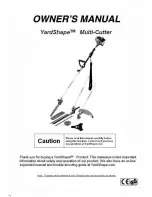
HK 31
30
INFORMATION
Durch variieren von Rotordrehzahl, Arbeitstiefe und
Arbeitsgeschwindigkeit wird die Howard Kreiselegge unter nahezu
allen Arbeitsbedingungen, den gewünschten Arbeitseffekt erbringen.
Verschiedene Anbautechniken und unterschiedliche Aufgeben
lassen sich mit dieser Maschine durchführen. Besonders geeignet ist
die Howard Kreiselegge zur effektiven Saatbettbereitung, wobei sie
im wesentlichen den feuchten Boden unten und den trockenen
Boden an der Oberfläche beläßt.
Zur Einstellung kann generell gesagt werden, daß eine niedrige
Arbeitsgeschwindigkeit und eine hohe Rotordrehzahl eine
feinkrümlige- und eine hohe Arbeitsgeschwindigkeit und niedrige
Rotordrehzahl eine grobkrümlige Bodenstruktur ergibt.
Bitte berücksichtigen Sie auch folgendes:
a) Niedrige Rotordrehzahlen benötigen weniger Leistung
b) Hohe Rotordrehzahlen erhöhen den Verschleiß und können
die Bodenstruktur zerstören.
c) Hohe Arbeitsgeschwindigkeiten in Kombination mit hoher
Rotordrehzahl sollten Sie nur auf gepflügtem oder gelockertem
Boden anwenden.
d) Führen Sie möglichst keine Bodenbearbeitung bei extrem
trockenen oder extrem nassen Bodenverhältnissen durch. Bei
sehr nassen Böden könnte sich ein Teil des Bodens an den
Werkzeugen bzw. am Packer festsetzen. Bei sehr trockenen
Bodenverhältnissen produzieren Sie viel Staub und haben
zudem einen hohen Werkzeugverschleiß.
Einsatz- Informationen
Stellen Sie zuerst die Arbeitstiefe und dann den Einebner ein.
Wählen Sie probeweise eine Rotordrehzahl.
Stellen Sie sicher, daß die Dreipunkthydraulik des Schleppers auf
Lageregelung eingestellt ist. Kreiselrotavator bis kurz über den
Boden ablassen, Zapfwelle einschalten, einen langsamen
Schleppergang einlegen, Gas geben und während des Anfahrens
den Kreiselrotavator ablassen.
Nach einer kurzen Strecke anhalten, die Arbeit überprüfen und
gegebenenfalls die Einstellung der Maschine ändern.
Falls Sie nicht die gewünschte Arbeitsqualität erreichen nehmen Sie
bitte die Checkliste auf Seite 32 zu Hilfe.
OPERATIONAL INFORMATION
By varying the speed of rotation of the soil working blades, the
cultivation depth and the forward travel speed of the tractor the
Harrovator will produce a range of tilths in most soil types.
Various cultivation techniques and a variety of tasks can be handled
by the Harrovator. It is however, particularly suitable for producing
seedbeds with moisture retained in the lower soil layers, quickly and
economically.
As a general principle fine tilths are produced by a combination of fast
blade rotation and slow tractor travel speeds. Conversely slower blade
rotation and faster tractor travel produces progressively coarser tilths.
The following operational characteristics should also be borne in
mind:
e) Slower blade rotational speeds require less power than higher
speeds.
f)
High blade rotational speeds increase blade wear and may
damage soil structure.
g) High travel speeds and fast blade rotation should be used only
for preparing shallow seedbeds on previously broken ground.
h) As far as possible avoid cultivation when the soil is excessively
wet or very dry. In conditions of high moisture content the soil
may >ball< and clog the blades; low moisture content produces
dust and high blade wear.
WORKING INFORMATION
Set the Depth Control equipment to the required tillage depth and
adjust the Levelling Bar accordingly.
Select a trial blade speed.
Ensure the tractor hydraulics are set to >position< not >draft< control.
Engage the tractor PTO and drive forward progressively lowering the
blades into the ground until full tillage depth is achieved.
Proceed for a short distance and check whether the resultant tilth is
satisfactory and uniform across the width of the Harrovator; if not
make appropriate adjustments to produce the reqired tilth utilising the
slowest blade speed which allows a reasonable speed of ground
coverage.
Should any problems be experienced in obtaining a high quality tilth
consult the Operators Checklist page 32 which provides remedies for
most operational problems.
M
Fig. 30/1




































